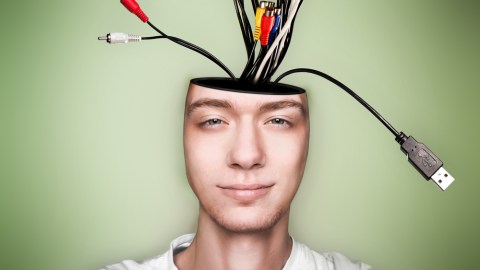The Internet’s Battle For Our Digital Souls

Harvard neuroscience researchers have just confirmed what many of us have suspected all along: social networks like Facebook, Twitter, Instagram and Pinterest are “brain candy” for Internet users. Every status update, every tweet, every pin is a micro-jolt delivered squarely to the pleasure centers of our brains. We get approximately the same type of pleasure from talking about ourselves on social media as we do from having sex. As Facebook bulks up to take on new challengers after its much-anticipated IPO next week, is it possible that the battle for future dominance on the Internet will actually take place inside our heads?
Emotions, visualizations and new ways to stimulate our senses suddenly matter more than ever on the Internet as companies figure out how to turn us all into Pavlovian subjects lusting after the next viral meme. Getting the neuroscience right, quite simply, is the key to future billion-dollar valuations. Viewed from this perspective, Zuckerberg’s recent billion-dollar grab for Instagram suddenly makes sense. It’s not just that Instagram is a hugely popular mobile network with millions of users, it’s that the company has figured out how retro filters and beautiful light effects actually trigger associations and memories deep within our unconscious minds.
What’s alternately terrifying and inspiring is how all this thinking about emotions, visuals and sensory stimulation is starting to flow through to the actual strategies of leading Internet competitors. For example, it’s no secret that Google has long been frustrated by Facebook’s dominance in the social networking space, despite numerous new initiatives to push its own Google+ social network forward. This week, Google might have finally cracked the code: a new iPhone and Android mobile app with “sense and soul” that takes everything rational, linear and orderly about Google+ (“Circles” – how geometrically rational!) and transforms it into something marvelously unstructured, nonlinear and stimulating:
“Sharing is deeply sensory. From cooking a favorite meal to getting together with friends, it’s the smells and the stories and the smiles that make human connections so essential. With Google+ we want to extend these moments online, so it’s only right to focus on the most personal of personal computers: your mobile phone. … To be clear, we’re not interested in a mobile or social experience that’s just smaller. We’re embracing the sensor-rich smartphone (with its touchable screen and high-density display), and transforming Google+ into something more intimate, and more expressive. Today’s new iPhone app is an important step in this direction—toward a simpler, more beautiful Google.”
To underscore this point, Google gave heavy prominence to a very Instagram-looking “fine feathered friend” in marvelous hues and tints.
Neuroscience, once at the periphery of the way we thought about the business world, is suddenly front and center. Companies are looking for ways to get inside our heads, to tinker with the very neurochemical transmitters that make us human. Of late, there has been a surge of books about the psychology of business and the neuroscience behind thoughts and emotions. These books hint at a future in which marketers can sell us more stuff, doctors can make us healthier, employers can make us more productive, and educators can make us smarter – just by understanding how the human brain works. By assocation, Internet companies can get more users by also understanding how the human brain works.
So what’s next? We are pushing against what some have called “the envelope of sensation” as we look for new ways to merge our physical and digital worlds. We desperately want our digital worlds to be as tactile and emotional and visual as the real world. We once thought of technologies such as augmented reality to be far-off and wacky – now they might just be around the corner. How far, exactly, are companies willing to go to blur the digital and the physical? In the battle for our digital souls, will there be a “brain candy” arms race, as companies compete with each other to rush out new innovations that flood our dopamine receptors with new stimuli?
image: Open-minded man with cables out head / Shutterstock




